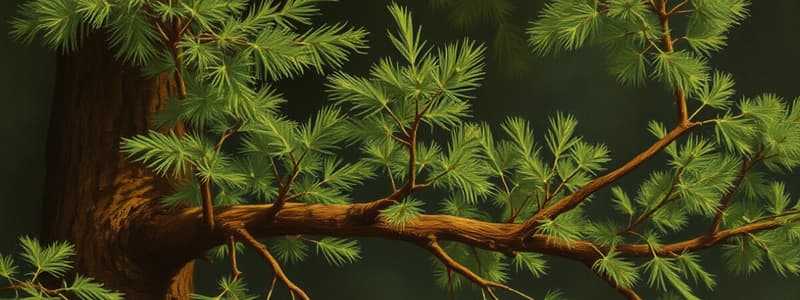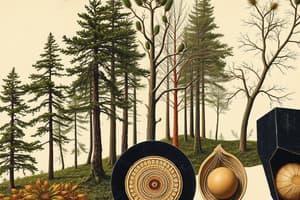Podcast
Questions and Answers
Which characteristic is unique to gymnosperms compared to angiosperms?
Which characteristic is unique to gymnosperms compared to angiosperms?
- Production of flowers
- Presence of vascular tissue
- Use of pollinators for reproduction
- Development of seeds within cones (correct)
What is the primary adaptation of angiosperms that enhances their reproductive success?
What is the primary adaptation of angiosperms that enhances their reproductive success?
- Deep root systems
- Thick bark for protection against herbivores
- Broad leaves for maximum sunlight absorption
- Involvement of animal pollinators (correct)
Which mechanism is NOT commonly used by plants for seed dispersal?
Which mechanism is NOT commonly used by plants for seed dispersal?
- Wind dispersal
- Animal ingestion
- Water transport
- Photosynthesis (correct)
What is the main function of the flower's stigma?
What is the main function of the flower's stigma?
Which statement about plant life cycles is accurate?
Which statement about plant life cycles is accurate?
Which factor is currently a significant ecological threat to plant diversity?
Which factor is currently a significant ecological threat to plant diversity?
Which statement correctly describes a characteristic of gymnosperms?
Which statement correctly describes a characteristic of gymnosperms?
What is a primary function of fruits in angiosperms?
What is a primary function of fruits in angiosperms?
Which feature of flowers is specifically adapted for attracting pollinators?
Which feature of flowers is specifically adapted for attracting pollinators?
Which statement about the life cycle of angiosperms is accurate?
Which statement about the life cycle of angiosperms is accurate?
Which of the following is NOT a method of seed dispersal for angiosperms?
Which of the following is NOT a method of seed dispersal for angiosperms?
What role do microspores play in the gymnosperm life cycle?
What role do microspores play in the gymnosperm life cycle?
Which adaptation is unique to angiosperms compared to gymnosperms?
Which adaptation is unique to angiosperms compared to gymnosperms?
Which structural component of a flower is typically responsible for enclosing the flower before it blooms?
Which structural component of a flower is typically responsible for enclosing the flower before it blooms?
Which characteristic is NOT associated with gymnosperms?
Which characteristic is NOT associated with gymnosperms?
In angiosperms, what is the primary function of the ovary?
In angiosperms, what is the primary function of the ovary?
What mechanism allows pollen to be dispersed without the need for water?
What mechanism allows pollen to be dispersed without the need for water?
Which phylum of gymnosperms is known for having only a single living species, Ginkgo biloba?
Which phylum of gymnosperms is known for having only a single living species, Ginkgo biloba?
During what conditions may seeds remain dormant for extended periods?
During what conditions may seeds remain dormant for extended periods?
Which of the following statements about plant life cycles is true?
Which of the following statements about plant life cycles is true?
Which phylum is characterized by large cones and palmlike leaves, and was prominent during the Mesozoic era?
Which phylum is characterized by large cones and palmlike leaves, and was prominent during the Mesozoic era?
How can seeds of plants be effectively spread to new areas?
How can seeds of plants be effectively spread to new areas?
Flashcards are hidden until you start studying
Study Notes
Gymnosperms and Their Life Cycle
- Gymnosperms have three defining features: dominance of the sporophyte generation, seed development from fertilized ovules, and sperm transfer via pollen.
- Pine trees serve as sporophytes, producing sporangia in both male (small cones) and female (larger cones) structures.
- Male cones generate microspores (pollen grains) that house male gametophytes.
- Female cones contain ovules that develop into megaspores, forming female gametophytes.
Angiosperms Overview
- Angiosperms, or flowering plants, are characterized by flowers and fruits and belong to the phylum Anthophyta, derived from the Greek word for flower.
- They are the most diverse and widespread group of plants.
Flowers
- The flower is specialized for sexual reproduction, attracting pollinators, especially insects and animals, while some undergo wind pollination.
- Composed of up to four types of modified leaves:
- Sepals: enclose the flower
- Petals: brightly colored to attract pollinators
- Stamens: produce pollen
- Carpels: produce ovules
Fruits
- Fruits usually consist of a mature ovary and may include other flower parts.
- Protect seeds and aid in their dispersal, which can be through wind, water, or animals.
- Mature fruits can be fleshy or dry, with various adaptations for seed dispersal.
Angiosperm Life Cycle
- The flower brings together male (stamens) and female (carpels) structures.
- Male gametophytes are found within pollen grains produced by microsporangia of anthers.
- Pollination is achieved through the transfer of pollen to the ovule; pollen can travel long distances via air or animals.
- Upon successful germination, pollen grains develop into pollen tubes that deliver sperm into the female gametophyte within the ovule.
Seed Development
- Seeds form from the ovule and contain a sporophyte embryo and food supply within a protective coat.
- Seeds can remain dormant for extended periods, from days to years, until conditions favor germination.
- Can be transported long distances by wind or animals.
Gymnosperm Phyla
- Cycadophyta: Features large cones and palmlike leaves; most abundant during the Mesozoic era, with few species remaining today.
- Ginkgophyta: Represents a single species, Ginkgo biloba, known for its pollution resistance and ornamental use.
- Gnetophyta: Includes three genera with varied appearances, some endemic to tropical regions and others to deserts.
- Coniferophyta: The largest gymnosperm phylum, consisting mostly of evergreens that perform photosynthesis year-round.
Plant and Animal Interactions
- Animals affect plant evolution through herbivory and pollination, leading to the development of plant defenses and mutual adaptations.
Importance of Seed Plants
- Seed plants are essential for human survival as they provide food, fuel, timber, and medicine.
- Conservation of plant diversity is critical due to our dependency on seed plants.
Ecological Threats to Plants
- Habitat destruction is leading to plant species extinctions, with 55,000 km² of tropical forest cleared annually.
- At current rates, tropical forests could vanish in 200 years, resulting in the loss of many animal species reliant on these plants.
- Predictions indicate that 50% of Earth’s species may face extinction within the next 100–200 years due to habitat loss.
Studying That Suits You
Use AI to generate personalized quizzes and flashcards to suit your learning preferences.




